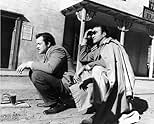Stanley Cortez(1908-1997)
- Cinematographer
- Camera and Electrical Department
- Visual Effects
Stanley Cortez was born Samuel Krantz in New York City, New York, the son of Sarah (Lefkowitz) and Moses/Morris Krantz, Austrian Jewish immigrants. His famous actor brother, born Jacob Krantz, changed his name to Ricardo Cortez in order to acquire a more suitably romantic Hollywood image. Stanley changed his name accordingly. After studies at New York
University he embarked on a photographic career, first as assistant to
noted portrait photographers Streichan and Bachrach (he designed many
of their lavish background sets), then as camera assistant for Pathé
Revue and for various Manhattan-based film companies. Grabbing the
chance to join Gloria Swanson Productions, Stanley then spent a lengthy apprenticeship in the
1920s and early 1930s learning the intricacies of his craft from such established Hollywood cinematographers as Lee Garmes and Hal Mohr. After moving from studio to
studio, either as a camera assistant or shooting screen tests, he was
signed to a seven-year contract by Universal in 1936, albeit consigned
to its "B" unit. His first film as full director of photography was
Four Days Wonder (1936). During World War II, he was assigned to the Army Pictorial Service of the Signals Corps.
Much of his subsequent career was spent on fairly routine and undistinguished second features and it was not until he started working for charismatic filmmakers like Orson Welles and David O. Selznick that he was able to fully develop some of his experimental techniques. One of his low-budget outings, a gothic old-dark-house horror/comedy entitled The Black Cat (1941), rather impressed the genial Mr. Welles who promptly hired him for The Magnificent Ambersons (1942). This was the first of two Cortez films generally regarded as visual masterpieces, with beautiful lighting effects, clever angles and lingering close-ups. Of particular note are the staircase scene and the famous long shot -- via hand-held camera -- of the abandoned mansion. Despite critical plaudits, "Ambersons" was a financial disaster for RKO (it cost $1,1 million and lost $624,000 at the box office) and Cortez was partly blamed for costly delays and extravagant scenes, some 40-50 minutes of which were cut by direct orders from studio boss George Schaefer without consulting either Welles or Cortez. The latter ended up being indirectly censured by receiving lesser assignments. What remained of "Ambersons" has become more appreciated as a sublime visual experience with the passing of time.
The second outstanding Cortez contribution was the chillingly dark, haunting thriller The Night of the Hunter (1955)--a brilliant allegory of good versus evil masterminded by Charles Laughton in his sole directorial effort. Cortez's lighting and use of irises are reminiscent of German expressionist cinema, or, at least, the work of Karl Struss and Charles Rosher on Sunrise: A Song of Two Humans (1927). Among many indelible images are the flowing hair of drowned Shelley Winters in the underwater current and the lights flickering across the water in what is an almost surreal nightly landscape.
A third Cortez effort deserving of mention is the superior psychological drama The Three Faces of Eve (1957), his differential lighting for the face of schizophrenic Eve White (Joanne Woodward) effectively contrasting the multiple personalities within her psyche. Sadly, by the end of the decade Cortez's career went into a decline. It continued that way through the 1960s, the quality of his assignments fluctuating wildly between the occasional "A" picture (The Bridge at Remagen (1969)) and Z-grade turkeys like The Ghost in the Invisible Bikini (1966) and The Navy vs. the Night Monsters (1966).
Much of his subsequent career was spent on fairly routine and undistinguished second features and it was not until he started working for charismatic filmmakers like Orson Welles and David O. Selznick that he was able to fully develop some of his experimental techniques. One of his low-budget outings, a gothic old-dark-house horror/comedy entitled The Black Cat (1941), rather impressed the genial Mr. Welles who promptly hired him for The Magnificent Ambersons (1942). This was the first of two Cortez films generally regarded as visual masterpieces, with beautiful lighting effects, clever angles and lingering close-ups. Of particular note are the staircase scene and the famous long shot -- via hand-held camera -- of the abandoned mansion. Despite critical plaudits, "Ambersons" was a financial disaster for RKO (it cost $1,1 million and lost $624,000 at the box office) and Cortez was partly blamed for costly delays and extravagant scenes, some 40-50 minutes of which were cut by direct orders from studio boss George Schaefer without consulting either Welles or Cortez. The latter ended up being indirectly censured by receiving lesser assignments. What remained of "Ambersons" has become more appreciated as a sublime visual experience with the passing of time.
The second outstanding Cortez contribution was the chillingly dark, haunting thriller The Night of the Hunter (1955)--a brilliant allegory of good versus evil masterminded by Charles Laughton in his sole directorial effort. Cortez's lighting and use of irises are reminiscent of German expressionist cinema, or, at least, the work of Karl Struss and Charles Rosher on Sunrise: A Song of Two Humans (1927). Among many indelible images are the flowing hair of drowned Shelley Winters in the underwater current and the lights flickering across the water in what is an almost surreal nightly landscape.
A third Cortez effort deserving of mention is the superior psychological drama The Three Faces of Eve (1957), his differential lighting for the face of schizophrenic Eve White (Joanne Woodward) effectively contrasting the multiple personalities within her psyche. Sadly, by the end of the decade Cortez's career went into a decline. It continued that way through the 1960s, the quality of his assignments fluctuating wildly between the occasional "A" picture (The Bridge at Remagen (1969)) and Z-grade turkeys like The Ghost in the Invisible Bikini (1966) and The Navy vs. the Night Monsters (1966).

































